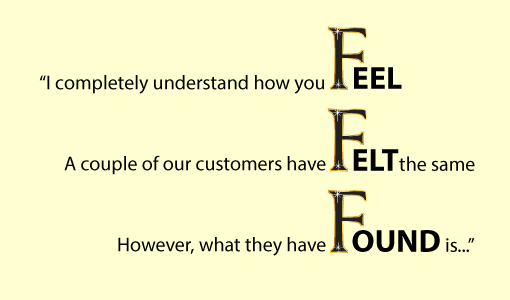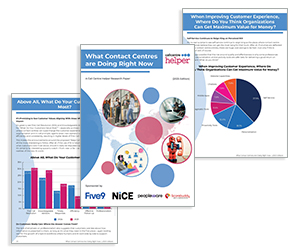Building rapport with customers isn’t about scripts, it’s about connection. Customers appreciate feeling heard, valued, and understood, which can make all the difference in their experience.
That’s why we have put together 15 ways to strengthen customer relationships and create more positive interactions.
How to Build Rapport With Customers
If you’re looking for tactics to build strong two-way conversations, here are some tips on rapport building with customers, along with snippets of advice from our readers.
1. Use the Customer’s Name
Debbie, one of our readers, suggests asking for the customer’s name first, rather than a reference number or address to help establish rapport:

“It is easy to get the details we need after we have their name. This makes the customer feel like an individual and advisors feel as if they are speaking with a person, not a caller.”
It is equally important to get the customer’s name right, as Carolyn Blunt, from Davies Learning Solutions, says: “many people accidentally call me Caroline and when they do that they completely lose rapport with me. This is because they haven’t paid enough attention or cared enough to get that right.”
Instead “if the customer has an unusual name, write it down phonetically when the customer is saying it instead of reading it off the CRM system.”
2. Pace and Lead
This technique is particularly effective when dealing with an over-excited or anxious customer. The key is to first match their energy, tone, and urgency, showing that you recognise their concerns and are taking them seriously.
Speak at a similar pace, reflect their level of enthusiasm or distress, and use reassuring language to build an instant connection.
Once you’ve established rapport, begin to gradually slow your speech and lower your tone. Maintain a calm and steady demeanour while providing clear solutions or next steps.
As long as the customer feels that their issue is being addressed and that you’re in sync with them, they will naturally begin to mirror your calmer state, helping to de-escalate the situation.
Contributed by: Michael
3. Take a Personal Interest
Building rapport is all about making the customer feel valued, and one of the best ways to do that is by showing genuine personal interest in their situation.
For example, if a customer mentions they’ve been in the hospital, take a moment to ask how they’re feeling or how their recovery is going. These small but thoughtful gestures show empathy and make the conversation feel more human.
If you were speaking to someone face-to-face and they mentioned a hospital stay, it would be natural to express concern. The same principle applies over the phone, acknowledging personal details in a warm and considerate way can help create a stronger connection and more positive interaction.
Contributed by: Lisa
4. Use Intonation Well
The way something is said can be just as important as the words themselves. Training agents to use effective intonation can enhance communication and rapport with customers.
For example:
- Raising the voice slightly at the end of a sentence signals a question and encourages engagement.
- Lowering the voice at the end of an instruction conveys confidence and authority, making it clear and reassuring.
You can see an example of the contrast between the warmer ‘language of love’ and sharp ‘nasal tone’ in the short video clip from Clinton Jordan below:
5. Allow Angry Customers to ‘Get It All Out’
Angry customers are the most difficult callers to build rapport with, but it’s not impossible, as long as the advisor lets them get it all out first.
Jennifer, a frequent visitor to the Call Centre Helper website, recommends this, saying: “When the customer is angry, allow them to vent without interruption.”
If they interrupt, the advisor will only be making the situation worse. It’s best to wait, and when the angry customer finally takes a breath, an empathy statement could be used to highlight that the situation has been recognized and understood.
Also, if the advisor uses this time to figure out what needs to be done to fix the issue, it is easier for them to present solutions to the customer instead of problems.
For more on how to deal with angry customers, read our article: Rapport Building With Angry Customers – With Examples
6. Repeat Back What the Customer Has Said
In many contact centres, a good example of rapport building is when advisors are encouraged to use reflective listening.
This – according to Sarah-Jane, whose contact centre does so – is where the advisor “repeats sentences or important details back to the customer, saying ‘Okay, just to recap…’”. This reassures the customer that the advisor is paying attention.
It is also important to mirror the customer’s tone, as Carolyn Blunt continues: “sometimes it’s about stopping and just moving on, thinking about how to match and mirror the customer’s mood and use similar words, phrases and tone.”
Top Tip – Listen out for the words and phrases that are being used, and if the customer has the same accent as the advisor, they should play to that.
Just a word of caution, don’t do this when the customer is aggressive, or if their accent is not the same (as trying to copy colloquial language could appear mocking or offensive).
That being said, if the customer is really bubbly and enthusiastic about a holiday that they are going on or a wedding that they are going to, then go for it! That enthusiasm should be mirrored.
7. Make Their Problem Your Problem
When looking at how to build rapport with customers, it’s key that advisors take “ownership of the enquiry, especially if it is a complaint” – according to Veronica, one of our readers.
“It’s important to have a one-to-one relationship with your customer so that they have a point of contact that they can come back to.”
So, when a customer voices their issue, it is important to acknowledge it and signal that their concern has been understood, so the customer feels as though the problem has been lifted from them.
Advisors can use statements such as: “I realise that this situation is difficult, but let’s try and find a solution” to do this. Such a statement begins with personal recognition using “I”, while it also finishes with “we” to create a notion of teamwork, which can boost rapport.
This approach also turns a negative into a positive, is more authentic than saying “I understand”, and creates a sense of action to show that the matter is important to the advisor and company.
If you want to coach your agents on acknowledging the customers, read our article: The Top 12 Acknowledgement Statements for Customer Service
8. Understand the Customer’s Emotional Drivers
When we discussed how to improve your emotional connection with customers, we concluded that customers will have two very different emotional drivers behind calling the contact centre.
These drivers are: movement away from pain or discomfort and movement towards pleasure. Normally one will be the dominant force.
When a customer seems worried, negative, or agitated, their dominant driver will be to move away from pain, and, if the advisor recognizes this, it is best to use empathy statements.
By contrast, if a customer is more upbeat – having called for a feeling of contentment, relief, or peace of mind – it is best the advisor stays enthusiastic.
If the advisor can tell which is the dominant driver behind the call and alter their style accordingly, they will increase their emotional connection with the customer and consequently build rapport.
9. Use Positive Scripting
Customer rapport can be tricky to achieve.
While many are against the use of scripts in contact centres, as they are often seen as a barrier to natural conversation, letting advisors know what they should not be saying and providing them with a list of positive alternatives can be beneficial.
This aids the rapport-building process, turning negative language (which can cause the customer to worry) into positivity that can instead trigger optimism.
Like these examples below:

If advisors can speak naturally, but refer to the list when they feel the urge to use a “negative” phrase, this can help to evoke positive emotions and rapport can be built more easily.
If you want to find out ways to create a positive scripting experience, read our article: How to Create a Positive Scripting Experience in Your Contact Centre
10. Be Flexible With Formality
A simple yet effective way to build rapport is by mirroring how the customer introduces themselves. If they say, “Hi, I’m James,” responding with “Great to speak with you, James!” creates an instant connection.
The screen may show them as Christopher Jones, but if the customer calls himself Chris, we will address him in the same way.

Some customers prefer to keep things more formal and may introduce themselves as Mr Jones. It depends on the business.
Contributed by: Stephen
11. Start Off With Something Positive
If the customer has spent some time explaining a frustrating problem, then beginning a response with a short, direct statement of intent can gain the customer’s confidence.
Something like “OK, we can fix this…” or “Right, let’s get this problem sorted for you…” will reassure the customer that the advisor is taking ownership of the problem.
If you want to find out examples of positive words and phrases to use on a customer call, read our article: The Top 25 Positive Words and Phrases for Customer Service
Contributed by: Matt
12. Keep Focused
Customers can always tell when they don’t have an agent’s full attention, which can make them feel unimportant or undervalued.
Advisors should stay 100% focused on the conversation, actively listening and avoiding distractions from colleagues, background noise, or notifications.
Whether in an office or working from home, maintaining full concentration ensures a more engaging, efficient, and positive customer experience.
Giving undivided attention not only helps resolve issues faster but also reassures the customer that they are truly being heard.
Contributed by: Laura
13. Let Advisors See Their Feedback
Providing advisors with direct access to customer feedback, especially post-call survey results and written or spoken comments, creates a powerful learning opportunity.
Seeing real customer reactions helps bridge the gap between what the advisor intended to convey and how the customer actually felt during the interaction.
This insight allows advisors to refine their approach, improve rapport-building techniques, and enhance overall customer satisfaction.
For the best impact, aim to share feedback in real time whenever possible, so advisors can immediately connect their actions with customer responses and make meaningful adjustments.
Contributed by: Alan
For more ways to collect customer feedback after a call, read our article: 25 Good Examples of How to Collect Customer Feedback
14. Use the Feel, Felt, Found Approach
Teach new advisors to use phrases that include the words feel, felt and found. An example of this can be found in the graphic below.

This helps to show empathy and reassure the customer.
Encourage advisors to structure responses like this:
- “I understand how you feel, many customers have felt the same way. But what they’ve found is that [solution or reassurance].”
This approach acknowledges the customer’s emotions, validates their concerns, and provides a positive resolution, helping to build trust and strengthen rapport.
Contributed by: Erik
15. Try Standing Up During the Call
If advisors can stand up and even move around while on a call can make a surprising difference in the conversation.
Studies suggest that good posture boosts confidence, energy levels, and overall engagement, which naturally enhances rapport with customers.
Standing up can also help with voice projection and clarity, making the advisor sound more enthusiastic and in control.
Contributed by: Nick
Video Insights – Definition of Rapport
For more on the meaning of building rapport, you can also watch this video, where Christine Knott explains what rapport is and why it is important:
This came from our webinar on How to Improve Rapport With the Customer.
For more advice on this topic, you can also read some of the following articles next:
- How do I – Build Rapport With Callers?
- Top Tips for Building Rapport on the Telephone
- Rapport-Building Tips
- How to Build Rapport on the Phone
Author: Megan Jones
Reviewed by: Hannah Swankie
Published On: 19th May 2023 - Last modified: 14th Aug 2025
Read more about - Skills, Angry Customers, Carolyn Blunt, Christine Knott, Customer Experience (CX), Editor's Picks, Empathy, Language, Rapport, Skill Development









































